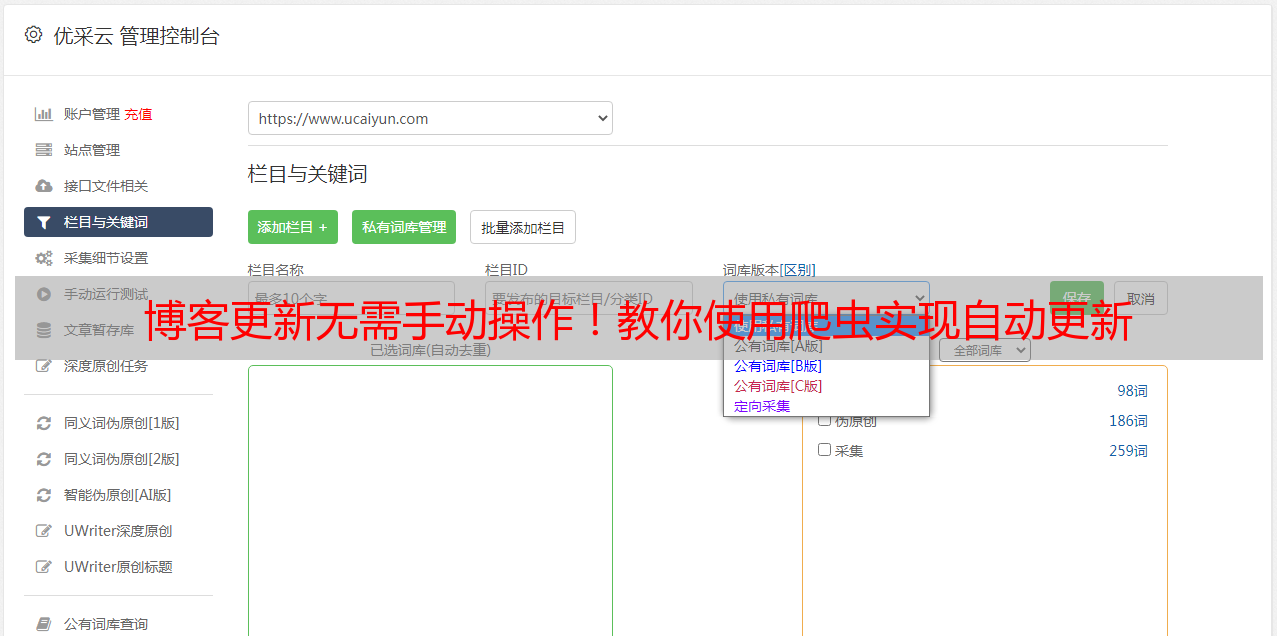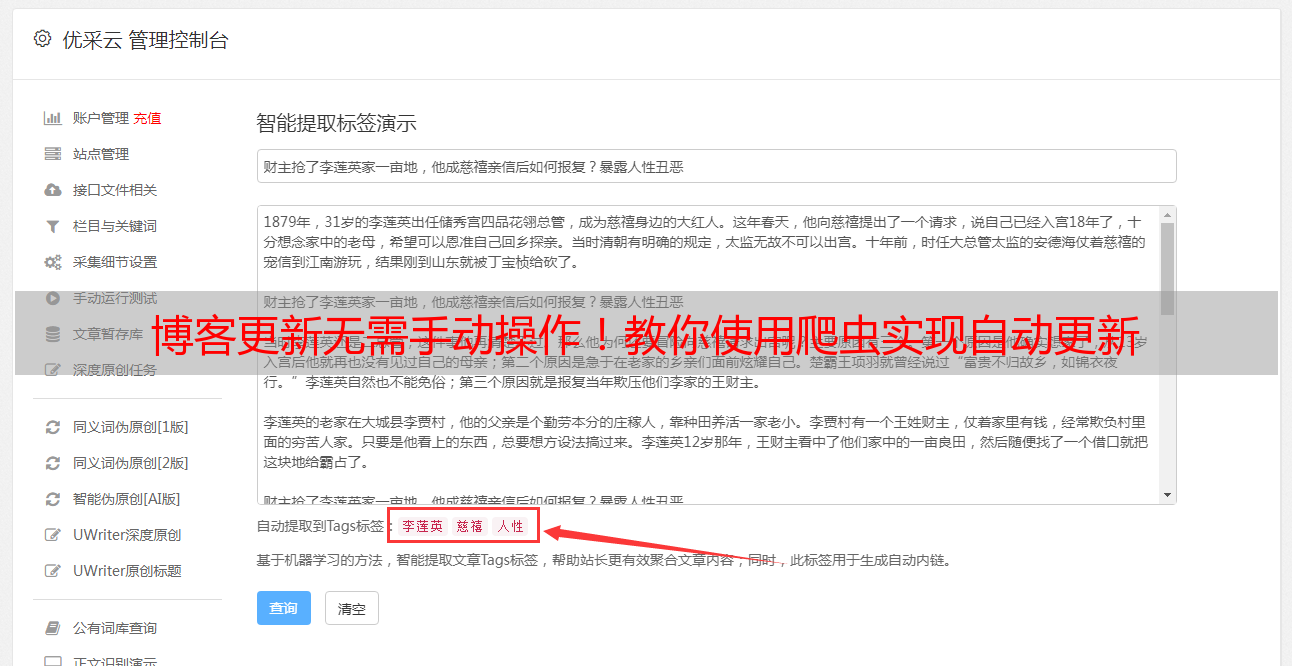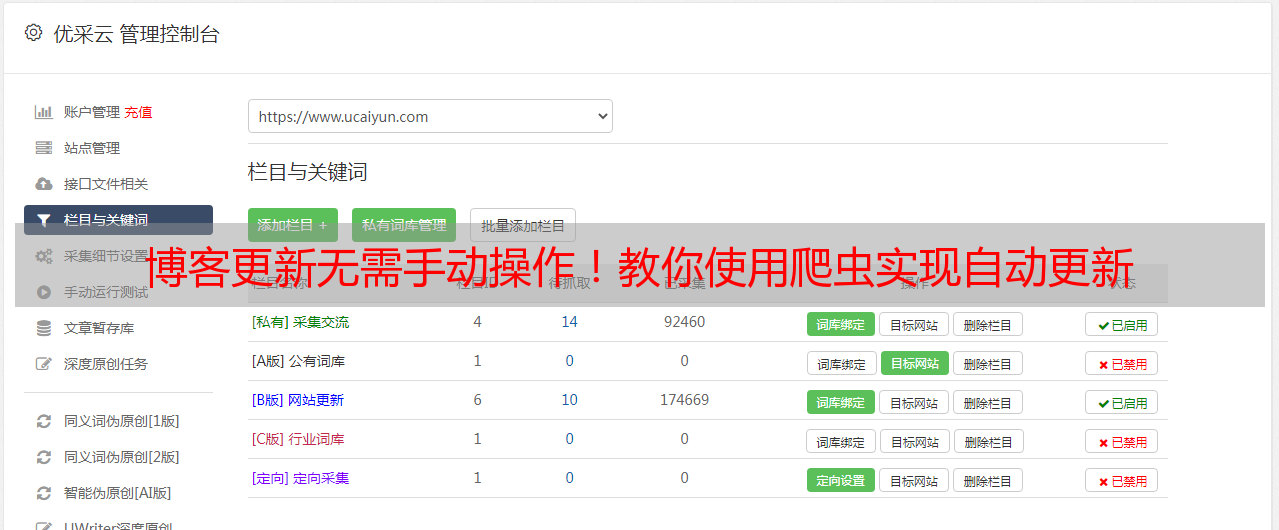博客更新无需手动操作!教你使用爬虫实现自动更新
优采云 发布时间: 2023-03-03 14:53在如今的互联网时代,博客已经成为了很多人展示自己的平台。但是,除了写好文章,还需要不断地更新。这对于忙碌的人来说是一个挑战。幸运的是,现在有了wordpress爬虫这个神器,可以让你的博客自动更新。本文将从以下几个方面详细介绍wordpress爬虫。
第一部分:什么是wordpress爬虫?
简单地说,wordpress爬虫就是通过程序自动抓取网页上的数据,并将其转换成可供wordpress系统识别和发布的文章格式。这样就可以实现博客自动更新,省去了手动更新的繁琐过程。
第二部分:如何使用wordpress爬虫?
首先需要安装一个支持python语言的IDE(集成开发环境)。然后编写代码并运行即可。下面以python语言为例进行介绍。
1. 安装所需库
使用pip安装所需的库:
``` python
pip install requests
pip install beautifulsoup4
pip install python-wordpress-xmlrpc
```
2. 编写抓取代码
``` python
import requests
from bs4 import BeautifulSoup
from wordpress_xmlrpc import Client, WordPressPost
from wordpress_xmlrpc.methods.posts import NewPost
# 设置wordpress账号和密码
client = Client('http://yourblog.com/xmlrpc.php', 'username', 'password')
# 设置要抓取的网页地址
url = 'http://example.com'
# 发送请求并解析返回结果
response = requests.get(url)
soup = BeautifulSoup(response.content, 'html.parser')
# 获取文章标题和内容
title = soup.find('h1').text.strip()
content = str(soup.find('div', {'class': 'post-content'}))
# 创建WordPressPost对象并设置标题、内容等属性
post = WordPressPost()
post.title = title
post.content = content
# 发布文章到wordpress博客中
client.call(NewPost(post))
```
3. 设置定时任务
使用linux系统中的cron工具可以设置定时任务,让程序定时执行抓取代码。例如,每天凌晨1点执行一次:
``` shell
0 1 * * * /usr/bin/python /path/to/crawler.py >/dev/null 2>&1
```
第三部分:如何优化wordpress爬虫?
如果抓取速度过慢或者出现被封IP等问题,可以考虑以下优化方法。
1. 使用代理IP
通过设置代理IP可以避免被封IP的问题,同时提高抓取速度。
2. 增加线程数
多线程能够同时进行多个任务,提高抓取速度。
3. 缓存数据
缓存已经抓取到的数据可以避免重复抓取,提高效率。
4. 使用反爬技术
一些网站可能会采用反爬技术,需要使用相应方法规避。
第四部分:实际案例分析
最后我们来看一个实际案例。假设我们想要从知乎上抓取关于机器学习方面的文章,并发布到我们的博客中。我们可以使用以下代码:
``` python
import requests
from bs4 import BeautifulSoup
from wordpress_xmlrpc import Client, WordPressPost
from wordpress_xmlrpc.methods.posts import NewPost
# 设置wordpress账号和密码
client = Client('http://yourblog.com/xmlrpc.php', 'username', 'password')
# 设置要抓取的知乎话题地址
url = 'https://www.zhihu.com/topic/19552832/hot'
# 发送请求并解析返回结果
response = requests.get(url)
soup = BeautifulSoup(response.content, 'html.parser')
for item in soup.find_all('div', {'class': 'feed-item'}):
# 获取文章标题和内容
title = item.find('a', {'class': 'question_link'}).text.strip()
content_url = item.find('a', {'class': 'question_link'})['href']
content_response = requests.get(content_url)
content_soup = BeautifulSoup(content_response.content, 'html.parser')
content_div = content_soup.find('div', {'class': 'QuestionRichText'})
# 创建WordPressPost对象并设置标题、内容等属性
post = WordPressPost()
post.title = title
# 将图片链接替换为本地链接(可选)
for img in content_div.find_all('img'):
img_url = img['src']
img_file_name = img_url.split('/')[-1]
with open(img_file_name, 'wb') as f:
f.write(requests.get(img_url).content)
img['src'] = '/path/to/img/' + img_file_name
post.content = str(content_div)
# 发布文章到wordpress博客中
client.call(NewPost(post))
```





